Ares J. Rosakis
Ares J. Rosakis Theodore von Kármán Professor of Aeronautics and Professor of Mechanical Engineering at the California Institute of Technology. He was also the fifth Director of the Graduate Aerospace Laboratories, known as (GALCIT), and formerly known as Guggenheim Aeronautical Laboratory, and was the Otis Booth Leadership Chair, of the Division of Engineering and Applied Science.
Ares J. Rosakis | |
|---|---|
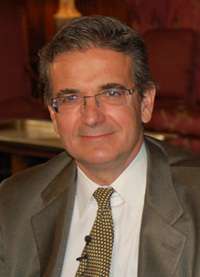 Ares J. Rosakis, Theodore von Kármán Professor of Aeronautics and Professor of Mechanical Engineering;Division of Engineering and Applied Science | |
| Born | 12 September 1956 Athens, Greece |
| Alma mater |
|
| Known for |
|
| Spouse(s) |
|
| Children |
|
| Awards | Eringen Medal (2011) Von Karman Medal (2016) |
| Scientific career | |
| Institutions | |
| Website | rosakis |
Education/Career
Ares Rosakis graduated from Athens College, a Greek-American high school in June 1975. In September 1975, he moved to the United Kingdom to attend University College Oxford to study engineering science. Dr. Rosakis received his BA and MA degrees in Engineering Science from Oxford University in 1978. He went on to earn his ScM and PhD degrees in solid mechanics from Brown University. He joined Caltech and GALCIT as an assistant professor in 1982 as the Institute's youngest tenure tract faculty member. He was promoted to the ranks of associate and full professor in 1988 and 1993 respectively. In 2004, he was named the Theodore von Kármán Professor of Aeronautics and Professor of Mechanical Engineering. In 2013, he was honored as the inaugural recipient of the Otis Booth Leadership Chair, Division of Engineering and Applied Science.
Research Interests
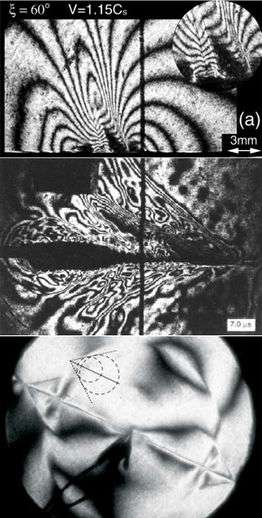
Professor Rosakis is the author of more than 260 works on quasi-static and dynamic failure of metals, composites, interfaces and sandwich structures, with emphasis on the use of high speed visible and IR diagnostics and laser interferometry for the study of dynamic fracture and dynamic localization. His early work includes the study of dynamic, ductile failure of structural metals by using high speed photography, the real-time measurement of temperature fields at the vicinity of dynamically growing cracks and adiabatic shear bands and the development of a variety of optical and dynamic infrared diagnostic methods. He and his coworkers invented Coherent Gradient Sensing, CGS, interferometry, a method sensitive to gradients of optical path gradients which has been used in both fracture mechanics and thin film stress measurements at the wafer level. Other interests include dynamic fragmentation; shear dominated intersonic rupture of inhomogeneous materials and composites, rupture mechanics of crustal earthquakes, shielding of spacecraft from hypervelocity micrometeoroid impact threats, the reliability of thin films and wafer level optical metrology. Professor Rosakis holds thirteen US patents on thin-film stress measurement and in situ wafer level metrology as well as on high speed infrared thermography.
In the late eighties, Rosakis introduced the concept of "laboratory earthquakes"[1] and since then his research interests have mainly focused on the mechanics of seismology, the physics of dynamic shear rupture and frictional sliding and on laboratory seismology. The goal of this body of work is to create, in a controlled and repeatable environment, surrogate laboratory earthquake scenarios mimicking various dynamic shear rupture process occurring in natural earthquake events. Such, highly instrumented, experiments are used to observe new physical phenomena and to also create benchmark comparisons with existing analysis and field observations. The experiments use high-speed photography, full-field photoelasticity, and laser velocimetry as diagnostics. The fault systems are simulated using two photoelastic plates held together in frictional contact. The far field tectonic loading is simulated by pre-compression while the triggering of dynamic rupture (spontaneous nucleation) is achieved by suddenly dropping the normal stress in a small region along the interface. The frictional interface (fault) forms various angles with the compression axis to provide the shear driving force necessary for continued rupturing. Rosakis and his co-workers, investigate the characteristics of rupture, such as rupture speed, rupture mode, associated ground motion under various conditions such as tectonic load, interface complexity and roughness. Both homogeneous and bimaterial interfaces (abutted by various elastic and damaged media) are investigated. Rosakis and his coworkers have been credited with the experimental discovery of the "intersonic" or "supershear rupture" phenomenon. They also have investigated this new phenomenon in various engineering and geophysical settings involving shear dominated rupture in the presence of weak interfaces or faults. Their experimental discoveries of supershear rupture has refocused the attention of the geophysics community to the study of supershear earthquakes.
Another recent research interest for Professor Rosakis is hypervelocity impact. Hypervelocity impact is a rising concern in spacecraft missions where man-made debris in low Earth orbit (LEO) and meteoroids are capable of compromising or depleting the structural integrity of spacecraft. To address these concerns, the goal of current research is to experimentally investigate the underlying mechanisms responsible for deformation and damage evolution during hypervelocity impact utilizing Caltech/JPL's Small Particle Hypervelocity Impact Range (SPHIR) facility. By combining high speed photography, optical, spectroscopic and infrared techniques, including Coherent Gradient Sensing (CGS) interferometry, the dynamic perforation behavior involving crater morphology, debris and ejecta formation and solid/fluid/plasma transitions and interactions have been examined.
Academic Leadership
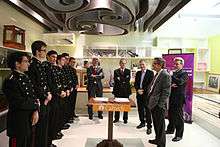
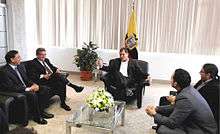
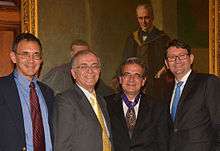
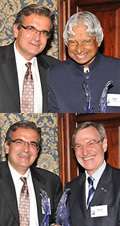
May 2009 – 2015, As EAS Division Chair
- 3 years in a row Engineering and Technology at Caltech was ranked #1 by the Times Higher Education World University Ranking (Thomson Reuters) for 2010-2011, 2011-2012,[2] and 2012-2013.
- Presided over the structural re-organization of the Division of Engineering and Applied Science (EAS) at Caltech.
- Replaced the amorphous degree option structure with seven EAS departments and presided over their administrative restructuring.
- Introduced a system of multiple fundraising advisory councils, composed of Caltech alumni and Institute trustees, corresponding to each new department.
- Established the Center for Technology and Management Education (CTME) which provides executive training, courses and certificate programs to international companies and government agencies.
- Involved in the establishment and oversight of the Resnick Energy Sustainability Institute which aims to foster transformational advances in energy science and technology through research, education, and communication.
- Member of the oversight board for the Joint Center for Artificial Photosynthesis (JCAP) with the mission to keep the United States at the forefront of solar fuel research.
- Oversaw the fundraising and renovation of the Jorgensen Laboratory to serve as the new home for two of Caltech's key energy and sustainability research efforts: the Resnick Institute and the Joint Center for Artificial Photosynthesis.
- Presided over, along with the Chair of the Division of Geology and Planetary Sciences, the establishment of the interdisciplinary Terrestrial Hazard Observation and Reporting (THOR) Center
- Established a graduate student exchange program between the Caltech's Division of Engineering and Applied Science and Institut Supérieur de l'Aéronautique et de l'Espace, located in Toulouse, France
- Appointed by the President of Ecuador as a founding member of the Board of Trustees of Yachay International University
- Created a partnership program with the Indian Space Research Organization (ISRO) and established the “Satish Dhawan” endowed fellowship sponsored by ISRO and the Government of India. Also created the “Abdul Kalam” prize in Aerospace.[3]
- Established the Charles M. Vest Engineering Grand Challenges Scholarship at Caltech for International collaboration (endorsed by NAE and RAE)
- Founded the new Department of Medical Engineering at Caltech within the Division of Engineering and Applied Science.
- Facilitated the establishment of the Caltech - Northrop Grumman Space Solar Power Initiative (SSPI).
- Spearheaded the establishment of the Foster and Coco Stanback Center for Autonomous Systems and Technology (CAST).
2004- 2009, As Director of GALCIT
- Led the initiative to revitalize the Graduate Aerospace Laboratories (GALCIT). Caltech was ranked #1 or #2 in Aerospace Engineering for the last six years by the U.S. News & World Report.[4]
- Five new faculty members hired between 2005 and 2007, increased the size of GALCIT faculty by 40%.
- Established Masters Program in Space Engineering, in collaboration with the Jet Propulsion Laboratory (JPL); initiated follow-on PhD program in Space Engineering; guaranteed the long-term viability of these programs through new fundraising for lectureships and fellowships.
- Established a two-year dual masters' program between GALCIT and École Polytechnique in France. The program received the 2010 Andrew Heiskell Award for Innovation in International Education from the Institute of International Education in New York.
- Established a Master's of PhD exchange program with the Government of Andalucía and the University of Seville.
- Oversaw extensive fundraising and renovation of the historic Guggenheim Laboratory following removal of 10-foot wind tunnel. Four labs built, the Laboratory for Large Space Structures, the Allen Puckett Laboratory of Computational Fluid Mechanics, the Gordon Cann Laboratory of Experimental Innovation, and the Joseph Charyk Center for Bio-Inspired Design; Kármán Conference room renovated and GALCIT Archives created (made possible by Robert Herzog); and extensive new classroom, conference, office, and social spaces created.
- Established the GALCIT Director's Advisory Board to extend the fundraising reach of GALCIT.
- Contributed to the establishment of the Keck Institute for Space Studies at Caltech and JPL.
- Led systematic effort to formally involve GALCIT and EAS faculty in joint research projects with JPL, the newly established Keck Institute for Space Studies, and the aerospace industry.
- Co-organized (with JPL and Northrop Grumman) an international conference to celebrate the 50th Anniversary of Space Exploration.
- Incorporated the Aerospace Historical Society (AHS) into GALCIT and became its president. Among other outreach activities the Society is annually responsible for awarding the International von Kármán Wings Award.
Caltech Leadership and Service
- Institute Cabinet for the Caltech Strategic Identity Project (The Caltech branding project)
- Member, Institute Academic Council (IACC)
- Member, Institute Administrative Council (IAC)
- Member, Steering Committee, Keck Institute for Space Studies (KISS)
- Chair, Lee-Ramo Symposia Committee, EAS Division
- Member, Committee for the Constitution of Caltech's “Institute for Space Science”
- Member, JPL Advisory Council
- Member, JPL Chief Technologist Selection Committee
- Member, Institute's Faculty Board (Caltech's governing body)
- Faculty Nominating Committee, Faculty Board
- Chair, GALCIT/JPL Committee for Space Engineering Education
- Member, EAS Division Steering Committee (DSC)
- Member, Planning Committee for the Future of the Engineering & Applied Sciences Division
- Participated and chaired over thirty departmental committees for faculty hiring, promotions, graduate student awards, laboratory staffing and renovation.
Honors and awards
Rosakis has been honored with many recognitions in mechanics, in aerospace and in materials failure including the 1989 Rudolf Kingslake Medal and Prize from the International Society of Optical Engineering (SPIE) and with various prizes awarded by the Society of Experimental Mechanics (SEM). These include the 1992 Hetényi Award,[5] the 1996 B. L. Lazan Award, and the 2003 Frocht Award.[6] In 2005 the same society selected him to become the William M. Murray Medalist and Lecturer for his lifelong contributions to the development and application of advanced methods for accurate measurement of transient, dynamic phenomena. In 2007 he received the Harting Award (SEM).
In 2009, he was elected a Fellow of the American Academy of Arts and Sciences (AAAS). In 2010, he received the Brown Engineering Alumni Medal (BEAM) Award from the Brown University School of Engineering, and the Robert Henry Thurston Award from the American Society of Mechanical Engineers (ASME). In 2011, he received the A. Cemal Eringen Medal from the Society of Engineering Science (SES) and he was elected Fellow of the National Academy of Engineering (NAE). In 2012, he was appointed Commandeur dans l'Ordre des Palmes Académiques from the Republic of France. In 2013, he received the P.S. Theocaris Award from the Society of Experimental Mechanics for his lifelong contribution to experimental science and mechanics,[7] he was elected member of the European Academy of Sciences and Arts (Academia Scientiarum et Artium Europaea), and he was elected Foreign Fellow of the Indian National Academy of Engineering (INAE) and a corresponding member of the Academy of Athens (National Academy of Greece). In 2014 he was elected member of Academia Europaea. In 2015 he received the Sia Nemat-Nasser Medal from SEM for his interdisciplinary utilization of experimental mechanics to advance the field of earthquake Seismology. And most recently in 2016, he was elected to the National Academy of Sciences[8] (NAS) and awarded the Theodore von Karman Medal of the American Society of Civil Engineers.[9]
ACADEMY MEMBERSHIPS AND PROFESSIONAL SOCIETIES
Academies:
- National Academy of Sciences (NAS) 2016
- Academia Europaea (AE) 2014
- Academy of Athens (AA)
- European Academy of Sciences and Arts (EASA) 2013
- Indian National Academy of Engineering (INAE) 2013
- National Academy of Engineering (NAE) 2011
- American Academy of Arts and Sciences (AAAS) 2009
- New York Academy of Science (NYAS) 1999
Associations and Societies:
- Seismological Society of America (SSA) 2009
- Society of Experimental Mechanics (SEM) 2009
- Aerospace Historical Society (AHS) 2007
- Aerospace Historical Society (AHS) 2006-09
- American Association for the Advancement of Science (AAAS)
- American Geophysical Union (AGU) 2004
- American Society of Mechanical Engineers (ASME) 1995
- Hellenic Society for Theoretical & Applied Mechanics (Greek chapter of IUTAM) 1984
- British Society for Strain Measurement (BSSM) 1978
- Eubean Studies Society, Athens, Greece (a historical society) 1975
- Robert Boyle Society, Oxford, U.K. (a scientific society) 1975
- Society of Engineering Science (SES)
- American Academy of Mechanics (AAM)
Publications
Professor Rosakis is the author of over 250 publications.
External links
- "Ares J. Rosakis | California Institute of Technology" rosakis.caltech.edu. Retrieved 2012-01-24.
- http://www.eas.caltech.edu/people/3177/profile
- Curriculum Vitae of Ares Rosakis
References
- "Laboratory Earthquakes: The Sub-Rayleigh-to-Supershear Rupture Transition, Vol. 303 no. 5665 pp. 1859-1861". Science. 2004.
- "Times Higher Education World University Ranking". Times Higher Education World University Ranking. 2011.
- "Abdul Kalam prize in Aerospace". GALCIT.
- "Caltech ranked #1 in Aerospace Engineering". GALCIT.
- "M. HETÉNYI Award". Society for Experimental Mechanics (SEM). 2008. Archived from the original on 2011-10-20. Retrieved 2012-01-05.
- "M.M. Frocht Award". Society for Experimental Mechanics (SEM). 2003. Archived from the original on 2011-10-20. Retrieved 2012-01-05.
- "Theocaris Award". Caltech News. 2013. Archived from the original on 2013-01-21. Retrieved 2013-04-24.
- National Academy of Sciences Members and Foreign Associates Elected, News from the National Academy of Sciences, National Academy of Sciences, May 3, 2016, archived from the original on May 6, 2016, retrieved 2016-05-14.
- "Theodore von Karman Medal Past Award Winners". ASCE. Retrieved 11 December 2016.